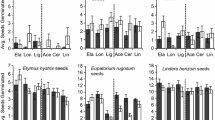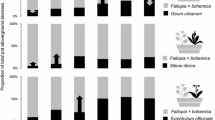Abstract
Biological invasions have become a major global issue in ecosystem conservation. As formalized in the “novel weapon hypothesis”, the allelopathic abilities of species are actively involved in invasion success. Here, we assume that allelopathy can also increase the biotic resistance of native species against invasion. We tested this hypothesis by studying the impact of the native species Sambucus ebulus on the colonization of propagules of the invasive species Fallopia x bohemica and the subsequent development of plants from these. Achenes and rhizome fragments from two natural populations were grown in a greenhouse experiment for 50 days. We used an experimental design that involved “donor” and “target” pots in order to separate resource competition from allelopathy. An allelopathic treatment effect was observed for plant growth but not for propagule establishment. Treatment affected, in particular, the growth of Fallopia plants originating from achenes, but there was less influence on plants originating from rhizomes. By day 50, shoot height had decreased by 27 % for plants originating from rhizomes and by 38 % for plants originating from achenes. The number of leaves for plants originating from achenes had only decreased by 20 %. Leaf and above- and below-ground dry masses decreased with treatment by 40, 41 and 25 % for plants originating from rhizomes and 70, 61 and 55 % for plants originating from achenes, respectively. S. ebulus extracts were analysed using high-performance chromatography, and the choice of test molecules was narrowed down. Our results suggest native species use allelopathy as a biotic containment mechanism against the naturalization of invasive species.




Similar content being viewed by others
References
Bailey J, Wisskirchen R (2006) The distribution and origins of Fallopia x bohemica (Polygonaceae) in Europe. Nord J Bot 24:173–199
Bailey JP, Bimova K, Mandak B (2009) Asexual spread versus sexual reproduction and evolution in Japanese Knotweed s.l. sets the stage for the “Battle of the Clones”. Biol Invasions 11:1189–1203
Callaway RM, Aschehoug ET (2000) Invasive plants versus their new and old neighbors: a mechanism for exotic invasion. Science 290:521–523
Callaway RM, Ridenour WM (2004) Novel weapons: invasive success and the evolution of increased competitive ability. Front Ecol Environ 2:436–443
Callaway RM, Ridenour WM, Laboski T, Weir T, Vivanco JM (2005) Natural selection for resistance to the allelopathic effects of invasive plants. J Ecol 93:576–583
Callaway RM, Cipollini D, Barto K, Thelen GC, Hallett SG, Prati D, Stinson K, Klironomos J (2008) Novel weapons: invasive plant suppresses fungal mutualists in America but not in its native Europe. Ecology 89:1043–1055
Cappuccino N, Arnason JT (2006) Novel chemistry of invasive exotic plants. Biol Lett 2:189–193
Catford JA, Jansson R, Nilsson C (2009) Reducing redundancy in invasion ecology by integrating hypotheses into a single theoretical framework. Divers Distrib 15:22–40
Cummings JA, Parker IM, Gilbert GS (2012) Allelopathy: a tool for weed management in forest restoration. Plant Ecol 213:1975–1989
Dorning M, Cipollini D (2006) Leaf and root extracts of the invasive shrub, Lonicera maackii, inhibit seed germination of three herbs with no autotoxic effects. Plant Ecol 184:287–296
Einhellig FA (1987) Interaction among allelochemicals and other stress factors of the plant environment. ACS Symp Ser 330:343–357
Einhellig FA, Eckrich PC (1984) Interactions of temperature and ferulic acid stress on grain-sorghum and soybeans. J Chem Ecol 10:161–170
Gurevitch J, Padilla DK (2004) Response to Ricciardi. Assessing species invasions as a cause of extinction. Trends Ecol Evol 19:620–620
Hackman RM, Polagruto JA, Zhu QY, Sun B, Fujii H, Keen CL (2008) Flavanols: digestion, absorption and bioactivity. Phytochem Rev 7:195–208
Hierro JL, Callaway RM (2003) Allelopathy and exotic plant invasion. Plant Soil 256:29–39
Inderjit, Wardle DA, Karban R, Callaway RM (2011) The ecosystem and evolutionary contexts of allelopathy. Trends Ecol Evol 26:655–662
Levine JM, Adler PB, Yelenik SG (2004) A meta-analysis of biotic resistance to exotic plant invasions. Ecol Lett 7:975–989
Li H-H, Inoue M, Nishimura H, Mizutani J, Tsuzuki E (1993) Interactions of trans-cinnamic acid, its related phenolic allelochemicals, and abscisic acid in seedling growth and seed germination of lettuce. J Chem Ecol 19:1775–1787
Macıas FA, Molinillo JM, Varela RM, Galindo JC (2007) Allelopathy—a natural alternative for weed control. Pest Manag Sci 63:327–348
Mandák B, Bímová K, Pyšek P, Štepánek J, Placková I (2005) Isoenzyme diversity in Reynoutria (Polygonaceae) taxa: escape from sterility by hybridization. Plant Syst Evol 253:219–230
Michalet R, Brooker RW, Cavieres LA, Kikvidze Z, Lortie CJ, Pugnaire FI, Valiente-Banuet A, Callaway RM (2006) Do biotic interactions shape both sides of the humped-back model of species richness in plant communities? Ecol Lett 9:767–773
Popovici J, Bertrand C, Jacquemoud D, Bellvert F, Fernandez MP, Comte G, Piola F (2011) An allelochemical from Myrica gale with strong phytotoxic activity against highly invasive Fallopia x bohemica taxa. Molecules 16:2323–2333
Pyšek P, Brock JH, Bímová K, Mandák B, Jarošik V, Koukoliková I, Pergl J, Štepánek J (2003) Vegetative regeneration in invasive Reynoutria (Polygonaceae) taxa: the determinant of invasibility at the genotype level. Am J Bot 90:1487–1495
R Development Core Team (2010) R: a language and environment for statistical computing. R Foundation for Statistical Computing, Vienna, Austria
Rice EL (1984) Allelopathy, 2nd edn. Academic, New York
Ridenour WM, Callaway RM (2001) The relative importance of allelopathy in interference: the effects of an invasive weed on a native bunchgrass. Oecologia 126:444–450
Rouifed S (2011) Bases scientifiques pour un contrôle des Renouées asiatiques. PhD thesis, Université Lyon1
Rouifed S, Puijalon S, Viricel M-R, Piola F (2011) Achenes buoyancy and germinability of the terrestrial invasive Fallopia x bohemica in aquatic environment: a new vector of dispersion? Ecoscience 18:79–84
Theoharides KA, Dukes JS (2007) Plant invasion across space and time: factors affecting nonindigenous species success during four stages of invasion. New Phytol 176:256–273
Thorpe AS, Thelen GC, Diaconu A, Callaway RM (2009) Root exudate is allelopathic in invaded community but not in native community: field evidence for the novel weapons hypothesis. J Ecol 97:641–645
Tiébré M-S, Saad L, Mahy G (2008) Landscape dynamics and habitat selection by the alien invasive Fallopia (Polygonaceae) in Belgium. Biodivers Conserv 17:2357–2370
Viard-Crétat F, Gallet C, Lefebvre M, Lavorel S (2009) A leachate a day keeps the seedlings away: mowing and the inhibitory effects of Festuca paniculata in subalpine grasslands. Ann Bot 103:1271–1278
Weidenhamer JD, Romeo JT (2005) Allelopathy as a mechanism for resisting invasion: the case of Polygonella myriophylla. International Symposium on Ecology of Biological Invasions (ed I. Inderjit). Unive Delhi, CEMDE, Delhi, India
Weisshuhn K, Prati D (2009) Activated carbon may have undesired side effects for testing allelopathy in invasive plants. Basic Appl Ecol 10:500–507
Acknowledgments
The authors would like to thank Denis Desbouchages for help during greenhouse experiments (FR 41, Université Lyon 1). This study was allowed thanks to the financial support of the project “Scientific basis for a control of Asian knotweeds” by FEDER (Plan Loire Grandeur Nature), Agence de l’Eau Loire Bretagne, Conseil Général du département de la Loire and Région Rhône-Alpes.
Author information
Authors and Affiliations
Corresponding author
Additional information
Communicated by: Beverley Glover
Rights and permissions
About this article
Cite this article
Christina, M., Rouifed, S., Puijalon, S. et al. Allelopathic effect of a native species on a major plant invader in Europe. Sci Nat 102, 12 (2015). https://doi.org/10.1007/s00114-015-1263-x
Received:
Revised:
Accepted:
Published:
DOI: https://doi.org/10.1007/s00114-015-1263-x




